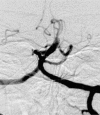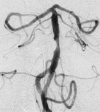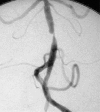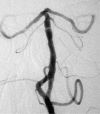Percutaneous transluminal angioplasty for atherosclerotic stenoses of intracranial vessels
- PMID: 20587243
- PMCID: PMC3522214
- DOI: 10.1177/15910199040100S204
Percutaneous transluminal angioplasty for atherosclerotic stenoses of intracranial vessels
Abstract
To study the efficacy and long-term outcome of percutaneous transluminal angioplasty (PTA) with/without stent placement for intracranial atherosclerotic stenoses, we reviewed our treated cases retrospectively. Between May 1992 and October 2003, PTA with/without stents was performed in 64 intracranial and skull base vessels in 62 patients, including 24 middle cerebral arteries, 16 internal carotid arteries, 13 vertebral arteries, and 11 basilar arteries. PTA was technically successful in 55 vessels (86%). However, four vessels (6%) failed to achieve satisfactory dilatation. We encountered five periprocedural strokes as symptomatic complications, for a mortality rate of 4.7% and a morbidity rate of 3.1%. All the patients with stent placements survived angioplasty without any complication. In the clinical follow-up available for one week to 11.5 years (mean, 4.7 years), there were three strokes related to the treated vessels. The annual stroke rate in the affected territory was estimated at 1.2% per year. According to these results, PTA for intracranial atherosclerotic stenoses seems to be a beneficial therapy for immediate anatomical results and long-term stroke prevention. Stent-assisted PTA could help patients achieve successful dilatation and avoid complications.
Figures





References
-
- Wholey MH, Al-Mubarek N, et al. Updated review of the global carotid artery stent registry. Catheter Cardiovasc Interv. 2003;60:259–266. - PubMed
-
- Cremonesi A, Manetti R, et al. Protected carotid stenting: clinical advantages and complications of embolic protection devices in 442 consecutive patients. Stroke. 2003;34:1936–1941. - PubMed
-
- CARESS Steering Committee. Carotid Revascularization Using Endarterectomy or Stenting Systems (CARESS): Phase I Clinical Trial. J Endovasc Ther. 2003;10:1021–1030. - PubMed
-
- Hobson RW., 2ND Rationale and status of randomized controlled clinical trials in carotid artery stenting. Semin Vasc Surg. 2003;16:311–316. - PubMed
-
- Bogousslavsky J, Barnett HJ, et al. Atherosclerotic disease of the middle cerebral artery. Stroke. 1986;17:1112–1120. - PubMed
LinkOut - more resources
Full Text Sources

